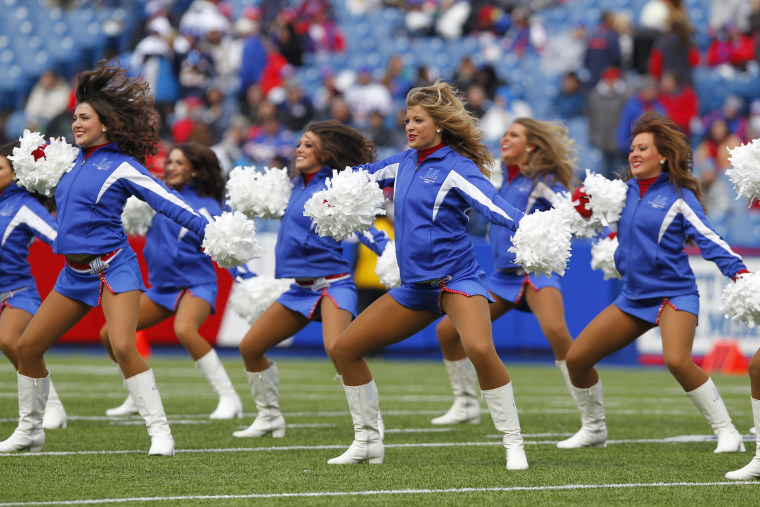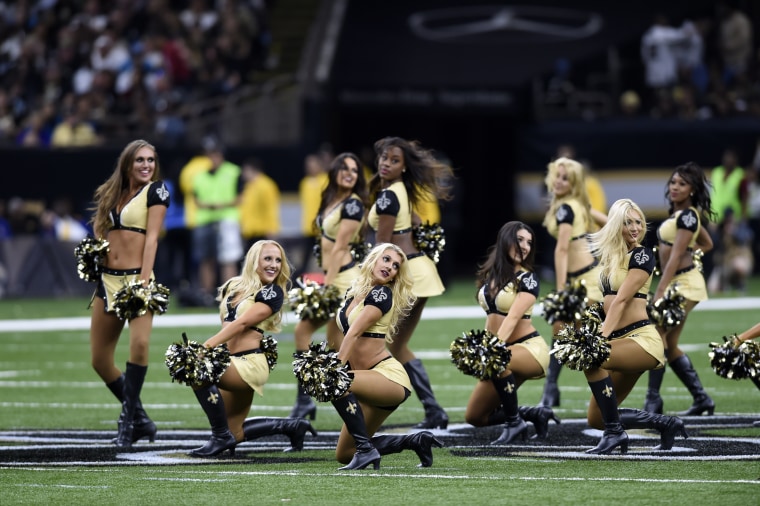The National Football League is well aware that female fans are one of its core audiences and it has tried over the last few years to bring more women into the fold. Yet, the league is constantly hindered by its own missteps in the quest to make women feel welcome. Poorly handled reports of gendered violence against players, criticisms of where the money raised to fight breast cancer goes, concerns about efforts to prevent and deal with domestic violence, problems with sexual harassment on the business side (with a team and a TV network), and a weird pandering to female fans as mainly consumers instead of as interested sports lovers, all have caused the league deserved headaches.
And then there is perhaps the most obvious example of how the NFL feels about women: the treatment of its cheerleaders.
And then there is perhaps the most obvious example of how the NFL feels about women: the treatment of its cheerleaders.
In March, former New Orleans Saints cheerleader Bailey Davis filed a complaint with the Equal Employment Opportunity Commission because, she says, the team treats female cheerleaders substantially different than male football players. In short, the New Orleans Saints are discriminating based on gender to the detriment of some of their female employees. According to the New York Times, “the Saints have an anti-fraternization policy that requires cheerleaders to avoid contact with players, in person or online, even though players are not penalized for pursuing such engagements with cheerleaders.” A cheerleader and a football player cannot be in the same restaurant and it’s the cheerleader’s obligation to leave, even if she arrived first.
Davis was fired after posting a picture of herself in a one-piece outfit on her private Instagram account, which violated the team’s prohibition of “appearing nude, seminude, or in lingerie.” The fact that the account was private did not matter because, apparently, once you sign on to be a cheerleader for a team, you must live with their specific code of conduct all the time.

The New York Times reports that the team claims these rules are designed “to protect cheerleaders from players preying on them.” Such a statement sends a decidedly ominous message about the behavior of the Saints’ own players. And even if Saints players truly cannot be trusted to be in the same room as Saints cheerleaders, this implies team management considers it the responsibility of the potential victims to prevent bad behavior from occurring. In other words, the team thinks the best way to handle this is to greatly curtail the behavior of the “prey,” not the people potentially doing the preying.
Despite all of these limitations and punitive rules associated with being a cheerleader, it makes sense that women still choose to be one. Like a lot of men, a lot of women want to be part of football. It’s just much harder to find space for yourself as a woman within the football world. They certainly can’t play in the NFL (though girls and women do play football all over this country).
Like a lot of men, a lot of women want to be part of football. It’s just much harder to find space for yourself as a woman within the football world.
They are also becoming coaches and referees, but women in either position is a recent phenomenon and the number of women who have been given that chance is still extremely low. Sports media is predominantly male (nearly 90%) and you can see the literal sidelining of women in NFL TV coverage. During the last season, Beth Mowins became the first woman ever to call a “Monday Night Football” game and the first woman in 30 years to call a regular-season NFL game — and even this deserved promotion was met with complaints.
You could try owning a team, but you probably have to be born into that. According to CBS News, “Women make up roughly half of all NFL fans but currently just a third of league employees – and they're have been no female head coaches or general managers.” Outside of being a fan of the sport (and the numbers there show how much women do want to be a part of the sport), there are few avenues to being directly involved. Except for cheerleading.
From the objectification and sexualization to the criminally low wages and extensive overreach into their non-cheerleading lives, cheerleaders must be willing to sacrifice to succeed.
From the objectification and sexualization to the criminally low wages and extensive overreach into their non-cheerleading lives, cheerleaders must be willing to sacrifice to succeed. In a follow-up piece to the one about Davis’ complaint, the New York Times reports that when it comes to the cheerleader/team dynamic, “the teams have all the leverage” because “supply outweighs the demand.” Not only do these women have to compete every year for their jobs, but there are often “thousands of women eager to join the squad” and take their place should they decide to leave (or, if they complain and are let go).
From a labor standpoint, the treatment of cheerleaders is yet another example of the NFL’s exploitative relationship with its employees. At least players, unlike cheerleaders, have a union. And even this does not stop the league from attempting to skirt around its responsibility when it comes to issues like the long-term damage due to concussions its players sustain, including denying disability benefits. The league cares only so much about the men who give their brains and bodies to it. The treatment of cheerleaders is but another example of its disregard for the people who represent the league to the public and make the games entertaining.
From a labor standpoint, the treatment of cheerleaders is yet another example of the NFL’s exploitative relationship with its employees.
The NFL has known about issues with the poor treatment of cheerleaders for years now. Cheerleaders from Oakland Raiders, Cincinnati Bengals, Tampa Bay Buccaneers, and the New York Jets have all sued over poor pay. The Bills decided to disband their squad — the Buffalo Jills — two days after five former cheerleaders sued over wages. These are teams that pull down millions of dollars in profit each year.
According to the New York Times, the NFL has argued in past cases that this isn’t a league issue, only a team one, and that each team is responsible for how it handles employees. Davis’ compliant, though, the Times reports, “centers on a fundamental league rule” that prohibits discrimination “regardless of whether it occurs in the workplace or in other NFL-sponsored settings.” The league might soon find out that looking the other way on how cheerleaders are treated is no longer an option.
A Wall Street Journal/NBC News poll found earlier this year that, “just 51% of men aged 18 to 49 say they follow the NFL closely, down from 75% four years ago.” If the league thinks women are one way to build its audience in the face of these kind of viewership changes, it should start by doing something about the sexism and exploitation faced by the women most closely associated with their teams. Don’t hold your breath, though.
Jessica Luther is a freelance journalist, author of "Unsportsmanlike Conduct: College Football And The Politics Of Rape," and co-host of the feminist sports podcast "Burn It All Down." She tweets at @jessicawluther.

